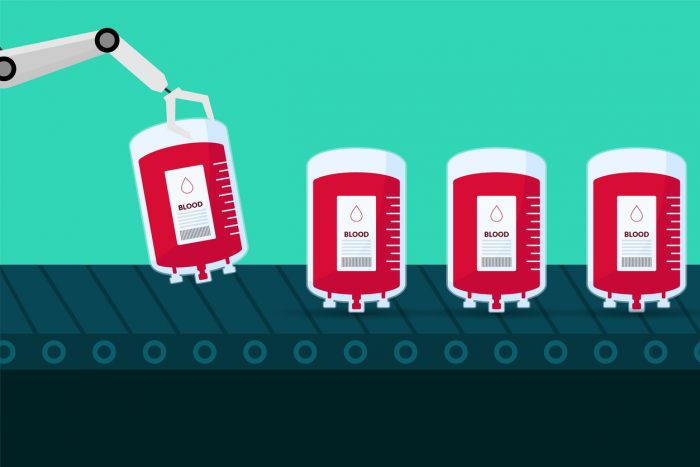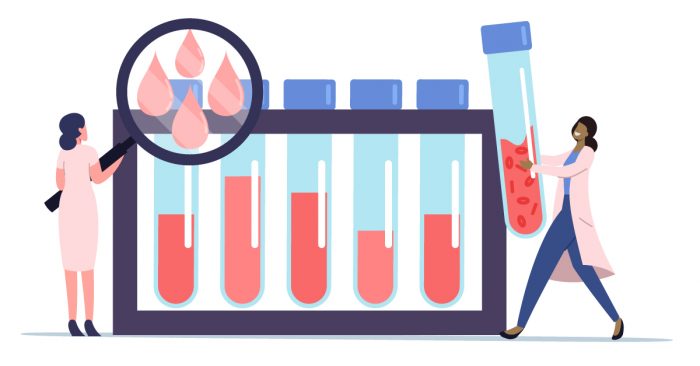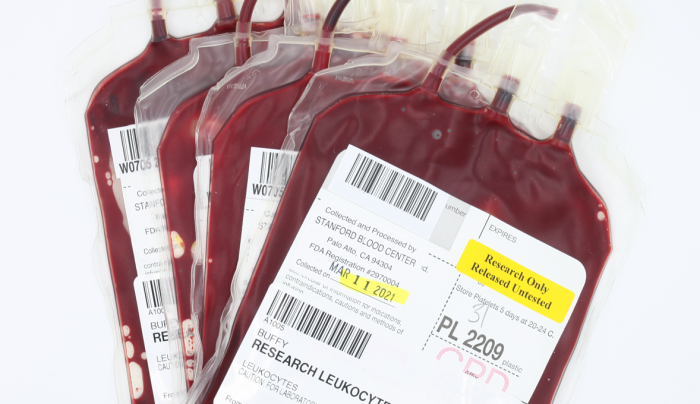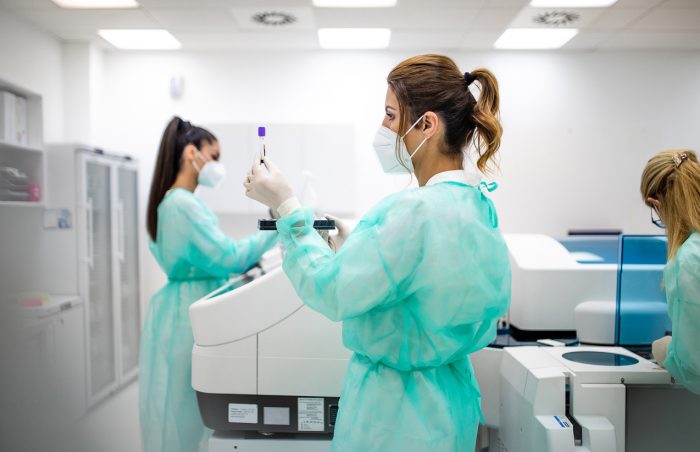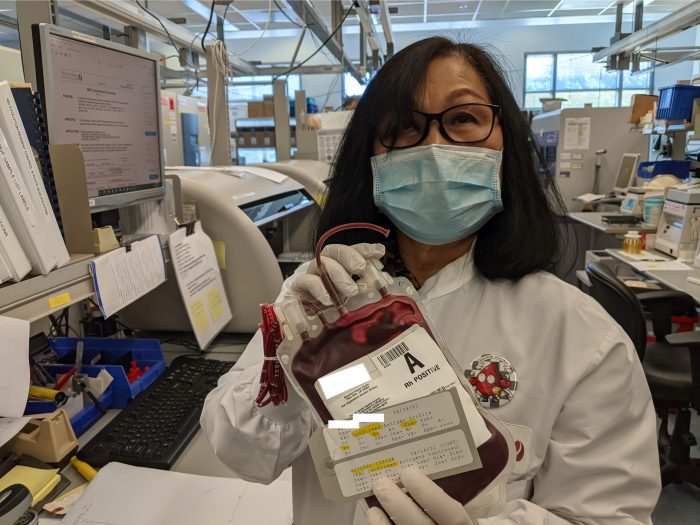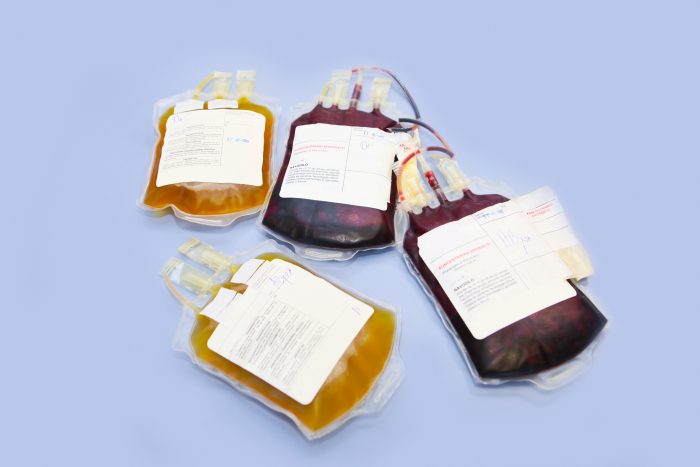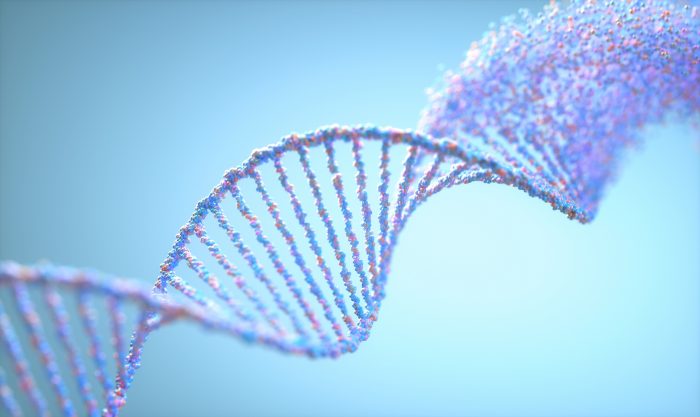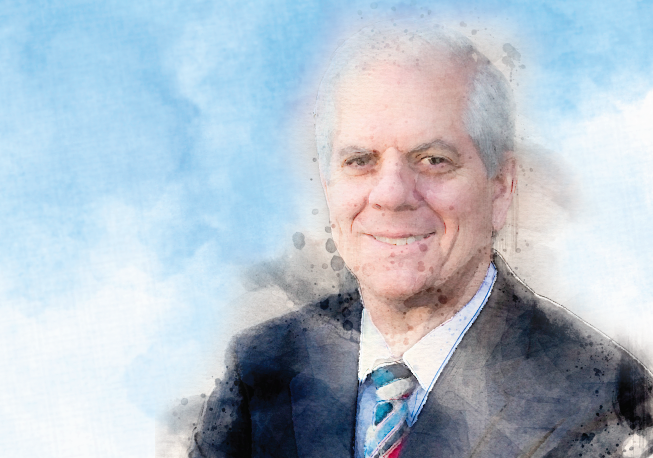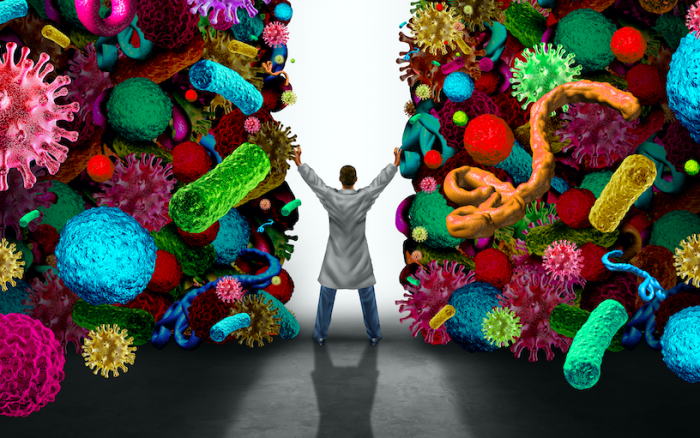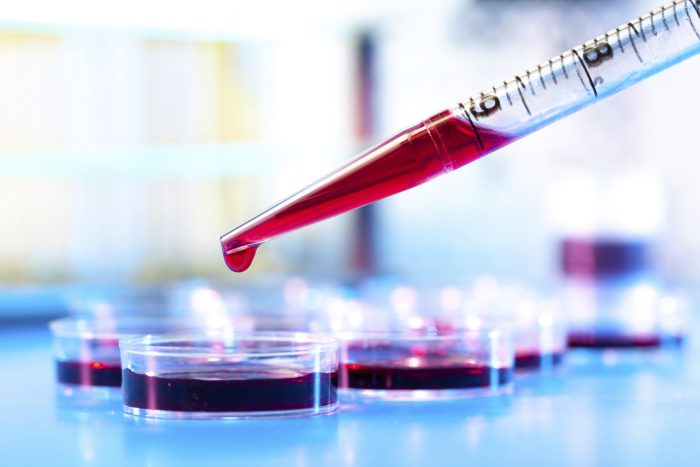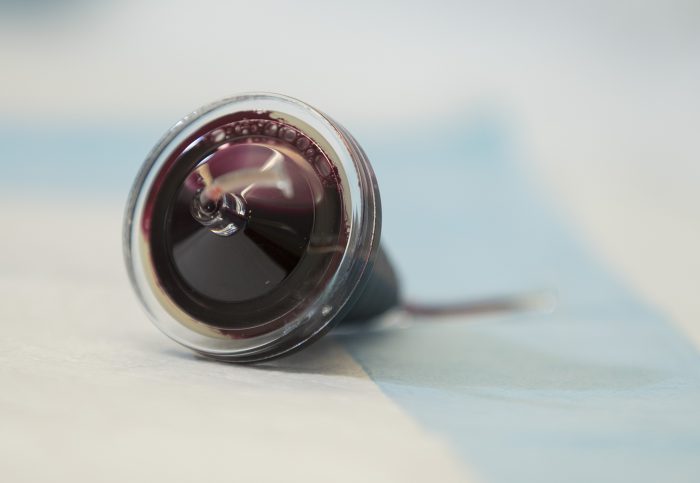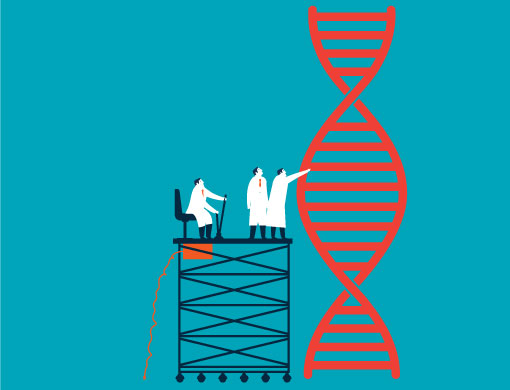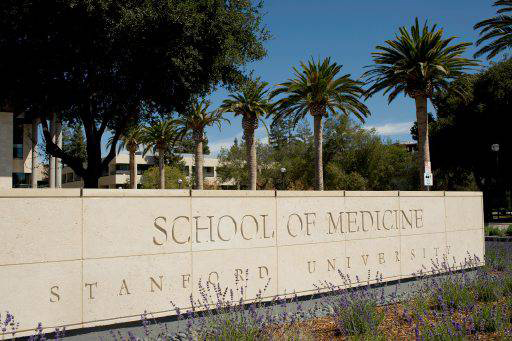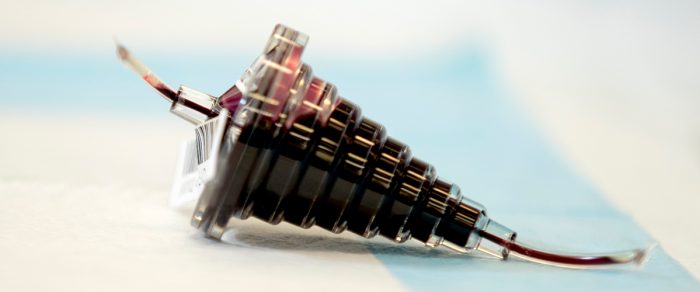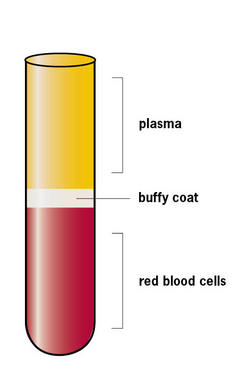
Think globally. Donate locally.
April 24, 2019 at 9:47 am
By Stanford Blood Center
Did you know that when you give blood with Stanford Blood Center (SBC), you’re not only helping local patients today, but you may also be contributing to medical research that will benefit the patients of tomorrow?
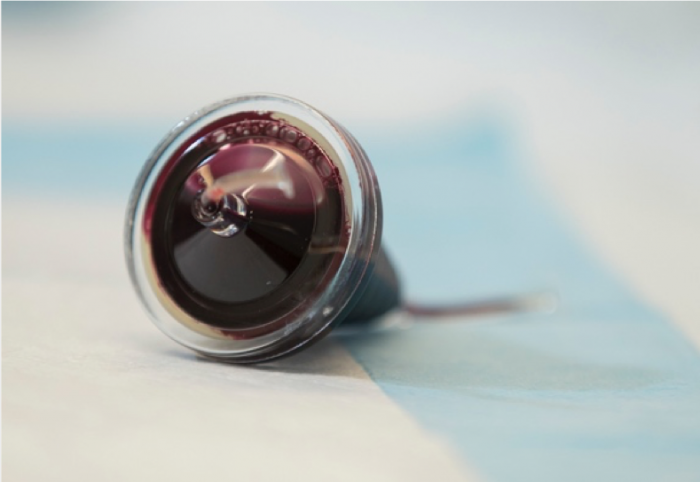 During the platelet donation process for instance, white blood cells — which are not suitable for transfusion and are typically discarded — are collected into a small device called an LRS (leukoreduction system) chamber. The LRS chamber is a conical-shaped filter used to separate the white blood cells (WBCs) from red cells and platelets. These white cells are an essential component used by researchers working to discover the causes, prevention and treatment of blood diseases and blood-borne disorders like leukemia, lymphoma, and sickle cell disease, among others.
During the platelet donation process for instance, white blood cells — which are not suitable for transfusion and are typically discarded — are collected into a small device called an LRS (leukoreduction system) chamber. The LRS chamber is a conical-shaped filter used to separate the white blood cells (WBCs) from red cells and platelets. These white cells are an essential component used by researchers working to discover the causes, prevention and treatment of blood diseases and blood-borne disorders like leukemia, lymphoma, and sickle cell disease, among others.
In addition, when a whole blood donation is made, SBC’s Components Lab tests and processes the whole blood donation, dividing it into several components: plasma, red blood cells, and a layer of white blood cells called buffy coats. Depending on need, the products are then shipped to partner hospitals or researchers.
So, each time you donate blood with Stanford Blood Center, not only will you save lives… you could be part of the cure.
Here are just a few examples of ways SBC is supporting groundbreaking medical research:
Leaders in Blood Science: Dr. Tamara Dunn
Dr. Tamara Dunn is a Clinical Associate Professor of Hematology at the Stanford School of Medicine, Associate Chair of Diversity and Inclusion for the Department of Medicine, and a practicing hematologist at the Palo Alto VA. In this conversation, she shares insights into her clinical work, her passion for mentoring the next generation of medical...
Artificial Blood: The Future of Patient Care?
By Krista Thomas, Communications Strategist As amazing and lifesaving as blood is, it’s not a perfect product. First, there’s the issue of shelf-life: Red blood cells can usually only be stored for up to 42 days, after which they should no longer be transfused to patients due to decreased efficacy. Then there’s the issue of...
Leucoreduction: How White Cells Are Separated
By Lorna Tolentino, Flow Cytometry Laboratory Manager As a blood donor, you likely already know that white blood cells are not transfused to patients. But do you know how and why the white cells are separated? Leucoreduction is a filtration technique used to remove white blood cells, or leukocytes, from platelet and red blood cell...
Buffy Coats: A Look at SBC’s Most Popular Research Product
By Marino Bozic, Research and Clinical Services Manager You’ve likely heard us say at SBC that when you donate blood, you’re helping the patients of today and tomorrow. But did you know the most likely way you’re helping these patients of tomorrow is with a small layer of white cells — only 30 mL per…
SBC Makes History and Enhances Platelet Safety by Going 100% PRT
By Harry Sussmann, Operational Excellence (OpEx) Director On April 28, Stanford Blood Center became the first blood center of its size in the nation to use pathogen reduction technology, or PRT, on 100% of its transfusable platelets produced. With this milestone, SBC is ensuring that the platelet units our donors generously provide are as safe…
SBC Begins Testing Donations for Rare Blood Groups
COVID-19 Convalescent Plasma
In the start of April 2020, SBC became one of the first blood centers in the nation to create a COVID-19 convalescent plasma (CCP) program. The program, which encouraged recovered COVID-19 patients to donate antibody-rich plasma for current COVID-19 patients, gained national media attention and led to over a thousand community members offering to donate….
Next-Generation Sequencing
By Deepti Sharma, PhD, Clinical Laboratory Scientist; Tamara A. Vayntrub, Project Manager; Bing Melody Zhang, MD, MS, FCAP, Assistant Director, HLA Lab SBC is now using next-generation sequencing (NGS) as the basis for its HLA typing method for both bone marrow and stem cell as well as solid organ transplants. The testing has already made…
Perspective From SBC’s Founder
Dr. Edgar Engleman is the founding Medical Director of Stanford Blood Center (SBC), as well as Professor of Pathology and Medicine at Stanford University. Over the course of his career, Dr. Engleman’s passion for supporting patients has fueled accomplishments that have radically transformed the blood industry and patient care. In particular, his unrivaled understanding of…
The Fascinating Journey of Peripheral Blood Mononuclear Cells
By Lorna Tolentino, Flow Cytometry Lab Manager Peripheral blood mononuclear cells (PBMCs) are a category of white blood cells that are of particular interest to researchers because of their unique structure. White blood cells can be broken down into two categories: granular and agranular. PBMCs are of the agranular variety, meaning that their cytoplasm does…
Supporting Research During a Pandemic
By Marino Bozic, Research Customer Relations Manager When Governor Gavin Newsom issued a shelter-in-place order for California on March 19, the Research Customer Relations department had no playbook for how to handle a research program during a pandemic. The first and most important decision we made was to remain open for business. While we anticipated…
Blood Products for Research: Participate in SBC’s Genetic Sequencing Study
In addition to providing blood products for local patients, Stanford Blood Center is committed to providing blood products for research. Researchers use these products to make breakthrough discoveries and help the patients of tomorrow. One way we are doing this is through our Genetic Sequencing Study. Genetic sequencing – which means reading sequences of DNA, the…
Primary Cells Product Offerings at SBC Help Further Scientific Research
In addition to providing blood products to use for transfusion and transplants, Stanford Blood Center (SBC) also collects blood products that play a major role in advancing medicine through research. Unlike most blood centers, we use every single part of your donation, including parts of your blood that might not be directly transfused into a…
Next Generation Sequencing – Ushering in a New Era of HLA Typing
As most of you know, in addition to providing lifesaving blood products for local patients, Stanford Blood Center is deeply committed to research initiatives to help the patients of tomorrow. On the forefront of much of this research is our Histocompatability, Immunogentics, and Disease Profiling Lab (the HLA Lab), who focuses on histocompatibility and genetic testing…
Training Future Leaders in Transfusion Medicine
As an academic blood center, teaching is an integral part of our mission at Stanford Blood Center (SBC). In 2007, to further this mission, SBC helped establish the Stanford Health Care (SHC) Transfusion Medicine (TM) Fellowship Program to train the future transfusion medicine specialists. The initial position was funded by SHC, our parent hospital, and…
Primary Cells Product Offerings at SBC Help Further Scientific Research
In addition to providing blood products to use for transfusion and transplants, Stanford Blood Center (SBC) also collects blood products that play a major role in advancing medicine through research. We took a look at the journey blood products take from donation to the research lab. When a whole blood donation is made, the product…
SBC’s Edgar Engleman, M.D. Finds That Vitamin A Suppresses Colon Cancer
Innovation is a guiding principle at Stanford Blood Center, and our founder is on the forefront of innovation in cancer treatment discoveries. Ed Engleman, M.D., recently conducted research into vitamin A’s role in suppressing colorectal cancer, the second leading cause of cancer mortality in the United States (Haggar and Boushey, 2009). Engleman’s study found that…
SBC Innovation: One (Centrifuge) Spin to Rule Them All
By Dianne Geary and Tho Pham, MD When a whole blood donation gets to lab, it goes for a spin in a centrifuge. From a whole blood unit, Stanford Blood Center (SBC) can then potentially get three products: packed red cells, plasma and buffy coat. Red cells and plasma products are used for transfusion, while buffy…
New Discoveries in the Fight Against Cancer
By Kristin Stankus, digital community and social media specialist Since its founding in 1978, Stanford Blood Center (SBC) has strived to not only save lives by providing transfusable blood products to patients in need, but also to provide tailored blood products and samples researchers utilize to contribute to the development of potentially lifesaving treatments and…
Hope in the Blood of Ebola Survivors
By Dayna Kerecman Myers Ebola is a devastating disease, but hope for a treatment may rest within the blood of survivors—along with the prospect of building stronger blood systems for the West African countries overwhelmed by the recent outbreak. When Ebola broke out in West Africa last year, the region’s fragile health systems could not…
Advancing Medicine: Use of Blood Products in Research
The Stanford Blood Center (SBC) mission states “We provide hope for the future: teaching tomorrow’s leaders in transfusion medicine, researching to unlock mysteries inherent in blood, and connecting donors to patients every day.” Part of the work SBC does to further our mission is provide blood byproducts to research labs at Stanford, throughout the Bay…
Are You My Type? BMT: The Ultimate Exercise in Matchmaking
Although Stanford Blood Center (SBC) is best known for supplying blood products to hospitals, did you know it is also home to one of the top Human Leukocyte Antigen (HLA) Histocompatibility laboratories in the country? While our donor centers do not collect bone marrow, SBC’s HLA lab supports the success of hundreds of bone marrow…
Research is a Treasure Hunt, Engleman Tells Tech Trek Students
| Tweet |
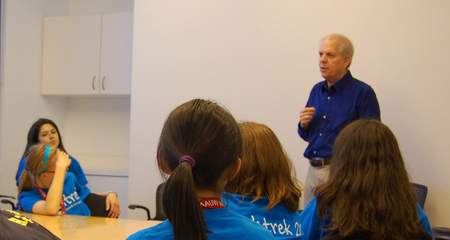
By Dayna Myers, Marketing Communications Manager, Stanford Blood Center
Stanford Blood Center founder and Medical Director Ed Engleman, MD, took a break from the lab to share his inspiring story with a group of students from the Tech Trek science and math camp on July 16.
Mammoth Effort: Scientists Turn to Ice Age Species to Develop Artificial Blood for Humans
By Lia Steakley, Social Media Producer, Stanford University School of Medicine

Woolly mammoths, which initially evolved in warm climates where African and Asian elephants now live, migrated to the cold regions of Eurasia in the Pleistocene glacial period. To survive living in the harsh permafrost, the Ice Age icons underwent distinct evolutionary changes such as growing long fur.
AIDS Screening: Stanford Blood Center’s Pioneering Role
By Ed Engleman, MD, Founder and Medical Director, Stanford Blood Center
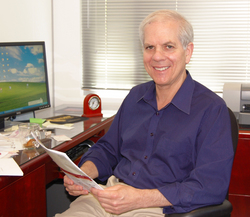
During the early 1980s we decided to apply new research technology to a clinical problem: the prevention of the transmission by transfusion of Acquired Immune Deficiency Syndrome (AIDS). The problem was highly charged with social, political, legal, ethical, and economic overtones complicating the technical and medical issues at hand. In a decision that engendered intense controversy, in 1983 Stanford Blood Center instituted the first blood testing program specifically intended to reduce the risk of transfusion transmission of the then uncharacterized, but presumed infectious cause of AIDS.
Some Reflections on the 30th Anniversary of AIDS
By Ruthann Richter, Director of Media Relations at the Stanford School of Medicine.
One of the many controversies I covered was the decision by the Stanford Blood Center to be the first in the country to test for the virus in donated blood. The move was reviled in the blood banking industry, for it called into question the safety and reliability of the nation’s blood supply. The blood center later would be vindicated, as every other bank would ultimately follow suit and routinely test for HIV. Center Director Ed Engleman, MD, says Stanford’s early initiative saved some 30,000 lives.
Type-2 Diabetes an Autoimmune Disease?
Tweet Guest post by Krista Conger, Science Writer for Communications & Public Affairs at Stanford School of Medicine. Click here to be taken to the original post on Scope, Stanford School of Medicine’s blog. Stanford researchers, led by pathologist Edgar Engleman, MD, reported today in Nature Medicine that type-2 diabetes is looking more and more…
Lifesaving Research at Stanford Blood Center
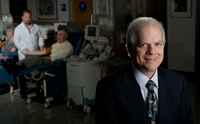
By Erin Crager, Marketing Intern, Stanford Blood Center
The collateral damage associated with chemotherapy and radiation treatment may soon be a thing of the past. Medical students have traditionally been taught that the body’s immune system generally doesn’t turn on itself, even in the presence of a tumor. But Ed Engleman, MD and his research team at Stanford Blood Center have developed a method for training the body’s immune system to do just that for prostate cancer. Their research over the past eighteen years has opened new doors for potentially curing other forms of cancer, as well.


